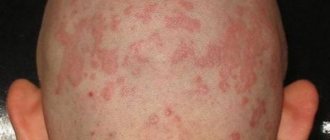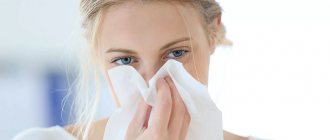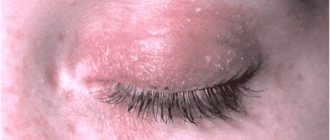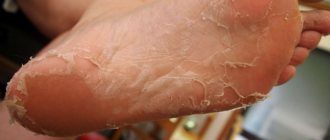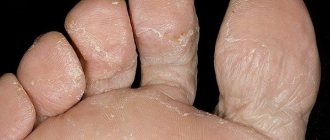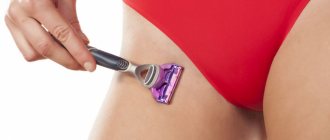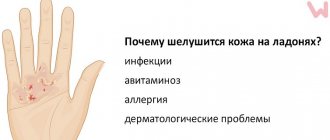Last update: 03/03/2021
The neck is one of the most sensitive areas of our body; the skin in this area is extremely susceptible to external influences, including those of an allergic nature. The appearance of allergies in the neck can cause unpleasant physical sensations and interfere with putting on clothes or taking a shower; In addition, psychological inconveniences associated with the manifestations of allergic reactions on open areas of the skin cannot be ruled out. This is why it is so important to know about the causes, symptoms and treatments for this disease.
Classification of the disease
There are four main types of miliaria, which differ in the nature of the rash, the duration of development and the severity of symptoms:
- Crystalline. It is accompanied by the development of a blistering rash, which most often appears on the head, behind the ears, and on the neck. Other localization of rashes is also possible. 2-3 days after the appearance, the blisters dry out and begin to peel off. Since irritation is not accompanied by inflammation or infection, the crystalline form is the simplest and most harmless.
- Red. A more complex type, in which sweat acts on the skin for a longer time and, accordingly, causes more severe irritation. A rash in the form of small inflamed tubercles provokes slight swelling and is accompanied by itching, burning, and discomfort. Lasts about two weeks.
- Miliaria alba, or vesiculopustulosis. With this type, blisters with a whitish or yellowish filling appear on the skin. When the bubble bursts, it leaves behind a light coating. The presence of color in the bubbly fluid indicates that the rash is accompanied by an infection, often staphylococcal.
- Deep. In most cases, prickly heat causes only superficial damage to the skin. With a deep form of pathology, the deep layers of the skin are affected. The disease is accompanied by blisters filled with light contents, which resolve or burst spontaneously.
Symptoms
The main and most obvious symptom of the pathology is a rash. Most often, rashes appear on the head, chest, back, groin, armpits, and buttocks. The rash appears as scattered blisters with clear, white or yellow contents, or as small grains with an inflammatory outline.
During the day, the rash may intensify or decrease, and the severity of its manifestation depends on changes in temperature and care for the baby’s skin. In some cases, the child does not show concern, but sometimes may experience itching, pain and demonstrate discomfort with whims, unstable sleep, and lack of appetite.
In mild forms of the disease, other symptoms may not occur. But in more advanced cases, which are accompanied by complications and infection, clinical manifestations may be supplemented by:
- elevated temperature up to 38 degrees;
- the appearance of light plaque, ulcers, ulcers;
- the formation of weeping cracks with an unpleasant odor;
- general deterioration of condition.
When assessing symptoms, it is important to prevent the development of advanced forms of prickly heat and consult a doctor promptly, without waiting for complications to develop. Source: Skin care for a newborn. Solntseva O.A. Medical Council, 2014. p. 35-39.
Causes
Most often, parents who do not adhere to the basic rules of caring for the child turn to doctors with complaints about heat rash in their baby: they bathe him with soap every day, wrap him up excessively without taking into account the real ambient temperature. Children with skin allergies, diabetes mellitus, rickets, seborrheic dermatitis or frequent diarrhea are also at risk. Chubby, overweight and bottle-fed babies are especially at risk of developing rashes.
Among other reasons for the development of prickly heat in children are:
- non-compliance with normal temperature conditions;
- too hot, tight clothes or shoes that do not allow air to pass through and do not create natural ventilation;
- excessive use of skin cosmetics that disrupt the acid balance and cause increased sensitivity (soaps, baby creams, oils, etc.);
- rare change of diapers or their poor quality, lack of care;
- viral diseases that are accompanied by fever.
How to distinguish heat rash in a child from allergies and other diseases
When a rash appears on the skin, the most difficult thing for parents is to distinguish prickly heat from other diseases: allergies, chicken pox, measles, etc.
First, you should examine the location of the rash. In the first case, the rashes are located in hard-to-reach places: in the area under the diaper, in the folds of the skin, in the hairline. In this case, the rash almost never appears on open areas of the skin that are well ventilated. But if the rash appears on the face, open parts of the arms and legs, most likely it is an allergy.
A simple home test will also help make a differential diagnosis. You just need to undress the baby and leave him without clothes or a diaper for several hours. If the rash appears as a result of prickly heat, during this time it will decrease and become paler. If it is an allergy, no changes will occur to it.
Additional symptoms will help distinguish the disease from measles, chickenpox and other viral pathologies. With infectious diseases, the temperature always rises, intoxication appears, and the rash quickly spreads throughout the body. In turn, the main symptom of prickly heat is just a rash.
Causes of neck allergies
Neck allergies can be caused by local exposure, or may be part of a systemic reaction to a particular allergen. Among the local causes that most often cause allergy symptoms on the skin of the neck are:
- Prolonged exposure to sweat (heat rash);
- Exposure to metal objects. Chains, necklaces, clasps and other items made of simple or precious metals may cause allergies when in prolonged contact with the skin;
- Cosmetics;
- External medications;
- Ultraviolet (usually in combination with other factors, for example chemicals).
In addition, neck allergies may be part of a systemic response to food allergens (fish, citrus fruits, berries, etc.), environmental factors (dust, pollen, microorganisms, wool), etc.
Diagnostics
You should not self-medicate or try to diagnose your child yourself. Before you begin to treat prickly heat in a child, when the first rash appears, you should contact a pediatric dermatologist or pediatrician. The specialist will conduct an examination and distinguish the pathology from other diseases that are accompanied by a skin rash. For an experienced pediatric specialist, this is not difficult even with an initial visual examination.
In some cases, additional examination is necessary for a comprehensive diagnosis. The doctor may prescribe scraping for pathogenic fungal infections, as well as bacterial culture for microflora.
Brief characteristics of the most common types of skin allergies
Hives
The term “urticaria” unites a whole group of diseases of different nature, but with a similar clinical symptom - blistering-type skin rashes, reminiscent of a nettle burn.
The causes of urticaria are varied. Skin allergies can develop as a result of a reaction to allergens (eg, food, insect bites, medications) or from physical causes such as exposure to the sun, cold, heat and pressure. Hives can be triggered by concomitant diseases of the gastrointestinal tract, endocrine system, or chronic infection.
A typical symptom of urticaria is the appearance of rashes on the skin accompanied by itching. The skin around them may be red. Sometimes all the elements on the affected area of the skin can merge together, forming giant blisters.
The main characteristic of skin allergies is the complete reversibility of blisters: after some time they disappear without a trace, leaving no traces, white spots or scars. But unlike a regular nettle burn, this disease appears again, and with a change in location: today the urticaria was on the legs, and tomorrow it can be found on the arms.
Allergic contact dermatitis
Allergic contact dermatitis is a skin allergy caused by direct exposure to an irritating substance, or allergen.
Most often, contact dermatitis is caused by household chemicals, cosmetics, various chemicals, nickel, latex, and some medications.
Allergic contact dermatitis develops on areas of the skin that have been or are in contact with an allergen.
The first symptoms and signs of contact dermatitis may not develop immediately, but some time after contact with the allergen - several hours, days or even weeks.
The main manifestations of allergic contact dermatitis: redness and swelling of a limited area of the skin that has been in contact with the allergen, severe itching in the area of redness, and the appearance of blisters of various sizes on the skin with a clear liquid inside. When damaged, the bubble bursts and erosion forms in its place. When the skin allergy subsides, yellow crusts remain for some time.
Atopic dermatitis
Atopic dermatitis is a chronic allergic skin disease accompanied by itching and rash. This skin allergy is common in infants and children and usually begins in the first 6 months of life, often continuing into adulthood.
Atopic dermatitis is a multifactorial disease. The leading factor is hereditary predisposition. Food and inhalant allergens play an important role. In childhood, the main food allergens are milk proteins, chicken eggs, fish, and grains. With age, inhalation allergens are added: house dust, animal hair, plant pollen.
Provoking factors for atopic dermatitis can be mechanical, physical or chemical irritants, increased sweating, tobacco smoke, stress, hormonal factors, and infection.
Atopic dermatitis has three sequential forms (infantile, childhood and adult dermatitis), differing in the characteristics of their manifestation.
Any form of atopic dermatitis is characterized by dry skin, itching, thickening of the skin with increased skin pattern, peeling, redness and rashes.
With atopic dermatitis, a vicious circle is formed: itching - scratching - rash - itching. The skin with atopic dermatitis is changed even without an exacerbation. Its structure and water balance are disturbed.
Eczema
Eczema is a chronic recurrent skin disease of allergic origin, characterized by a polymorphic itchy rash (vesicles, erythema, papules). The causes of eczema can be very different, from external factors (chemicals, drugs, food and bacterial allergens) to internal ones.
Exacerbations of this type of skin allergy occur under the influence of psycho-emotional stress, diet disorders, contact with chemicals and other allergens.
Depending on the cause of the appearance and location of the rash, several types of eczema are distinguished: seborrheic, true, occupational, microbial. The areas where the rash is localized tend to itch and peel, causing a lot of inconvenience to the person. Eczema is chronic with periods of exacerbations and remissions, and treatment of skin allergies is often complicated by the addition of pyoderma or herpes. With skin allergies of this type, changes in the functional activity of the digestive tract, metabolic processes, neuroendocrine disorders, and vegetative-vascular dystonia can also be observed.
Toxidermy
Toxidermia is an acute toxic-allergic inflammatory skin lesion, which is an allergic reaction to the introduction into the body (inhalation, ingestion, parenteral administration) of substances with allergenic properties.
The causes of toxicerma are most often drugs and food products.
More often, widespread toxicerma is observed, which is manifested by multiple rashes and itching. Often this type of skin allergy involves the mucous membranes, which may also have various rashes.
In addition to the common one, fixed toxicoderma is possible, in which one or more swollen red spots of round or oval shape appear; in some cases, a bubble may form in the center of each of them. Typically, such skin allergies are associated with taking medications. After the action of the allergen ceases, the inflammatory phenomena subside, and the stain remains for a long time. The most severe forms of toxicerma are Stevens-Johnson syndrome and Lyell's syndrome. They are considered emergencies and require hospitalization.
With a huge variety of allergic dermatoses themselves, there are diseases with similar symptoms. For example, a rash can accompany some infections, diseases of internal organs, etc. Therefore, do not try to diagnose yourself with “skin allergies” and do not self-medicate.
Only a doctor, having collected a detailed history and conducted the necessary examination, will be able to determine the exact cause of the disease and prescribe medications that are suitable in each specific case.
Treatment
The main method that allows you to remove rashes and cure skin pathologies is hygienic care. It is important to change the diaper immediately after a bowel movement and every three hours, washing the baby with running water. Between shifts you need to give air baths and leave the baby without clothes for a few minutes. At the same time, it is necessary to abandon synthetic clothing and low-quality children's cosmetics.
Bathing is carried out in water with a decoction of medicinal herbs. You can add chamomile, yarrow, and string. After bathing the child, dry thoroughly and powder the skin with powder.
In some cases, the doctor also prescribes treatment of rashes with drying antiseptics (“Furacilin”, “Chlorphilipt”), and creams containing panthenol (“Bepanten”, “Dexpanthenol”). White, red and deep miliaria are treated with antifungal and antibacterial ointments. However, it is not recommended to use any medications without prior consultation with a doctor. Source: Modern dermatological and cosmetic products for caring for the skin of children. Kotlukov V.K., Kuzmenko L.G., Antipova N.V. Medical Council, 2013. p. 8-12.
Doctors recommend setting the air temperature in the nursery at 20-22 degrees and monitoring the humidity, which should not exceed 50-70%. A good solution would be to purchase an air humidifier that will help create the right microclimate. These simple steps can help you get rid of the conditions that increase your risk of developing heat rash.
Allergy treatment
The basic principle of treating any allergic reaction is to eliminate the causes that caused it. In addition, patients are often prescribed a special elimination diet to protect themselves from food allergens. In the treatment of allergies, anti-allergic and anti-inflammatory drugs of local and systemic action are also used.
Of great importance in the treatment of allergic reactions is the elimination of the most unpleasant symptoms: redness, burning, itching. La-Cri products, compatible with modern anti-allergy drugs, can help with this:
- La-Cri cream reduces burning and itching, helps reduce erythema (redness);
- Emulsion "La-Cri"
allows you to make the skin less sensitive, get rid of flaking and dryness; - Cleansing gel "La-Cri"
allows you to cleanse the skin of irritants and allergens.
Prevention
Effective prevention consists of proper and thorough hygienic care of the child: regular bathing, frequent changing of diapers or diapers. During the hot season, you can bathe your baby up to 2-4 times a day, but it is important not to use soap, oils, lotions and other products with each water procedure that can disrupt the acid balance and clog the glands.
It is also important to select clothes from natural, breathable fabrics and avoid synthetic and semi-synthetic fabrics that do not ensure normal evaporation of sweat. You need to dress your baby appropriately for the weather and not wrap him up in a warm blanket on a summer night. Source: Skin care for infants. Prevention of diaper dermatitis. Starostina L.S. Medical Council, 2022. p. 41-49.
Sources:
- Skin care for infants. Prevention of diaper dermatitis. Starostina L.S. Medical Council, 2022. p. 41-49
- Newborn skin care. Solntseva O.A. Medical Council, 2014. p. 35-39
- Modern dermatological and cosmetic products for the care of children's skin. Kotlukov V.K., Kuzmenko L.G., Antipova N.V. Medical Council, 2013. p. 8-12
Date of publication: 10/20/2017
The information in this article is provided for reference purposes and does not replace advice from a qualified professional. Don't self-medicate! At the first signs of illness, you should consult a doctor.
How can the symptoms that appear be eliminated?
Treatment of itching and hyperemia of the skin in the neck area is directly determined by the cause of this condition.
Treatment in case of an allergic reaction
When the neck itches due to allergies, the use of antihistamines is recommended, both local and general. An effective treatment regimen often looks like this:
- For topical use – Hydrocortisone ointment. It contains a hormone that reduces the intensity of the inflammatory reaction. You can also use Fenistil ointment. It contains an antihistamine that reduces the intensity of itching.
- For planned therapy - Loratadine or Cetrin in tablet form. Take 1 tablet/evening, course: 5 – 7 days.
- An emergency remedy (if necessary for swelling of the subcutaneous tissue) is an antihistamine (or glucocorticoid hormone) in parenteral form. As a rule, Tavegil or Suprastin is used. Prescribed 2 ml/injection in adults, 1 ml in children. Dexamethasone is also used in 1 ml or 0.5 ml doses, respectively. The result can be seen within a few minutes after administration.
For burns
- Panthenol. Apply to the affected area 2-4 times a day.
- Libyan (in aerosol form). Spray onto burnt skin once.
- Hydrocortisone 0.5-1%. Apply to the surface of the skin up to 4 times a day.
- Floceta. Apply a thin layer 2-3 times a day.
Read also: Itchy palms and feet: reasons, how to treat itchy feet and palms
The course of treatment is individual for each patient.
Read more in the article
For insect bites
- Bepanten. The product is suitable for mosquito bites that are very itchy and red. Course of treatment: 1-3 days, smear two to three times a day.
- Fenistil. Apply 2 to 4 times a day, course - until symptoms disappear.
- Zinc ointment. Apply to itchy skin 3 times a day for 2-4 days.
Read more in the article
You can get rid of itching after midge bites by smearing the bite site with menthol ointment, chlorhexidine or Menovazin.
If your neck itches due to shaving or other mechanical damage
- In this case, it is recommended to use salicylic acid. Apply to skin 2-3 times a day. The maximum duration of therapy is no more than 7 days.
- Bepanten. Apply a thin layer to irritated skin at least 2 times a day.
- Cream Vagisil. Apply the product to the skin after each shaving procedure or when you feel discomfort.
Panthenol cream can be used for irritation on the neck, some types of dermatitis and damage to the skin.
For neck itching caused by diseases
Regarding other pathologies, we can say that their treatment is so specific that it cannot be prescribed without prior consultation with a specialist. In the case of psoriasis and neurodermatitis, there is no etiotropic treatment at all, since the origin of these diseases is not completely clear.
